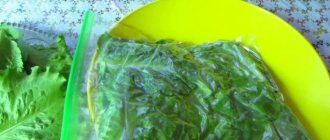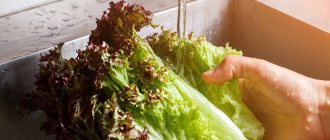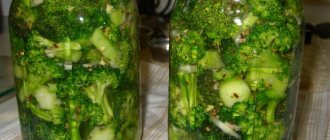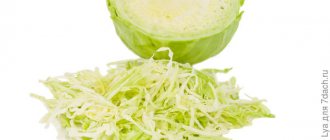Iceberg: sowing in the ground and seedling method, or get a treat without the hassle
Undoubtedly, planting lettuce in open ground with grown seedlings is simpler and easier. But this is only on one side. On the other hand, there is the need to arrange a heated greenhouse or grow lettuce on a windowsill. Agree, this is not the best option, besides, these are not only small plants that lack warmth and light, but also sand and excess moisture in the house.
Growing lettuce in open ground: positive aspects
An excellent option is to sow seeds in open ground. It has the following advantages:
- simplicity. To do this, you do not need to prepare a substrate, cups or seedling cassettes. Everything can be done right away in the garden;
- efficiency of cultivation. Technical ripeness of Iceberg lettuce is achieved in 45-50 days. Add here another 10-14 days, during which your family will have time to eat it - and you can safely sow again!;
- ease of care for sown seeds. In the garden bed, it is easier to cover the seeds with spunbond (through which you can water!) or greenhouse film than to build a greenhouse on the windowsill.
So, we have become familiar with the positive aspects of sowing lettuce in open ground. Where to start working in the garden? From purchasing seeds!
Attention! Buy seeds from a specialty store. This is the only way you will be protected from fakes and get an excellent harvest.
Sowing process in several steps
In order to sow Iceberg in the garden, you need to find a place for it. The salad simply tolerates direct sunlight, so this will not be a problem. But it’s worth taking care of the soil. It should be light, well structured, not sour. Otherwise, special medications will help correct the problem. To get started you need:
Planting lettuce
- prepare the bed, that is, dig it up, compact it a little, water it and make grooves around the perimeter to make it easier to water adult plants and the water does not go beyond the bed;
- make grooves in the bed 2-2.5 cm deep and the same width. The distance between the grooves is 15-20 cm if you grow lettuce for greens, 30-40 cm if you want to get full heads of cabbage. Row furrows can be made with the corner of a hoe or shingles by drawing lines on the ground with pressure;
- sow seeds. The best option is panned ones, which are larger in diameter, have a supply of nutrients, and are better visible. If the seeds are ordinary, you can mix them with river sand. You cannot sow thickly;
- Carefully level the grooves and compact the soil;
- spill the garden bed.
If you sow seeds in early spring and the temperature is low, cover the bed with covering material. When the temperature rises to 15-17°C, the bed should be opened.
Attention! Iceberg tolerates average temperatures well, but nights below +12°C and daytime temperatures above +30°C do not provide the desired development. The lettuce stops gaining weight and shoots. Therefore, it is better to grow Iceberg in early spring, late autumn, and you can also sow lettuce before winter.
Recommendations before sowing in the country
- The culture prefers loamy or sandy loam, neutral soils . Therefore, to reduce acidity, dolomite flour, wood ash or limestone are first added to the ground.
- To prevent plant diseases, planting is carried out in accordance with crop rotation requirements. It is advisable that cabbage, potatoes, onions or grains grew in the beds last year.
- Lettuce is a crop that can accumulate nitrates in its leaves. Therefore, nitrate fertilizers should be applied with caution. It is better to fertilize with humus, compost, or manure in the fall before planting.
- Early ripening and decorative appearance allows it to be grown not only as a monoculture in a separate bed. It can also be grown together with potatoes, onions, carrots or between the rows of zucchini and cucumbers. While these crops are growing and gaining strength, the lettuce will have time to ripen. And the spectacular look with carved leaves is used to decorate flower beds.
- Choose sunny places or partial shade .
- The culture is cold-resistant and can withstand frosts down to -2 -6 degrees. Growth begins at +5 degrees. And the optimal temperature for active growth is +18+25 degrees.
- To increase the harvest period, you can sow in several stages, every 10-14 days.
- It is recommended to germinate the seeds in a damp cloth one day before sowing.
Contraindications and harm
The only contraindication to the inclusion of this type of salad greens is individual intolerance. Some people simply cannot eat fresh vegetables and salads due to the presence of bitterness in the mouth, which may be accompanied by pain and colic in the area of the liver and pancreas.
People with urolithiasis, gout, enterocolitis and colitis should limit its consumption.
Potential harm may come from the way the lettuce is grown. If sanitary standards are not observed, it may contain increased amounts of nitrates and other harmful substances.
Serves as a prevention of heart and vascular diseases;
- What to do if the leaves are slightly wilted
- Conditions and term
- In a bowl of water
- Under a colander
- In packages
- Flower way
- Preparation
- Conditions and shelf life of Iceberg lettuce
- Why does iceberg lettuce turn red when cut?
- Why is iceberg lettuce bitter?
- Conclusion
- Properties of Iceberg lettuce. The benefits and harms of Iceberg lettuce. Composition and beneficial substances of iceberg lettuce.
- For men
- How to choose Iceberg lettuce
- Iceberg lettuce in cooking
- How to wash properly?
- How to cut?
- Vegetable and fruit salads
- Salads with dressing
- What to take for nature?
- Under the film
- In a bowl of water
- Pickling
How to freeze salad
Here are some storage tips to help ensure your lettuce survives the arctic challenges as intact as possible. Handling the leaves carefully as you cook them will give you the least mushy results.
- If you separate the leaves, they will set faster and clearer. Separating them also makes it easier to identify and remove wilted or damaged leaves. We recommend washing each leaf to ensure it is completely clean before hibernation. Lettuce leaves with thick stems freeze better when the stem is removed. Leave thinner stems for varieties with tender leaves to keep the leaves intact.
- Dry the leaves as long as possible before freezing them. You can pat them dry with a towel or leave them in a strainer to dry.
- Once dry, place them in a freezer bag. Don't stuff the leaves into the bag as if you were raking fall leaves. It is better to carefully place them one at a time.
- When the bag is relatively full, try to remove as much air as possible from it. You can leave a tiny hole and gently press down on the bag, or fold the open end around a straw and suck out the air. If you have a vacuum sealing system, use low power to avoid crushing leaves.
Frozen lettuce is great in soups, stir-fries and casseroles. You can use it in omelettes, pies, or anywhere else you would normally use spinach.
An even easier way to freeze salad is to mix it with a little water and freeze the puree in an ice cube tray. You can use these nutritious ice cubes in smoothies and juices.
How long does salad stay fresh?
Once harvested, the quality of any type of lettuce begins to deteriorate. If you buy lettuce at a large grocery store, it may have been a few days or even weeks since it was harvested.
This means you'll want to choose the freshest one you can find. But even the crispiest leaves don't last long in the pantry or on the kitchen shelf.
If you leave the salad, there will be enough for about:
- 2 hours at room temperature
- 1 hour if the room temperature is above 30°C
- Temperatures from 4°C to 60°C are the best conditions for bacteria. Under these ideal conditions, the number of bacteria feeding on lettuce can double every 20 minutes. Lettuce left for a couple of hours in this delicious bacterial climate will lose its crispness and begin to wilt. The edges may curl and turn brown. If you're in the middle of a heat wave, your lettuce can start to wilt in less than an hour.
Growing Iceberg Lettuce
Headed forms of lettuce have not yet found a sufficient number of fans, since most vegetable growers prefer leafy varieties of this crop. At the same time, the appetizing crispy heads of cabbage are better stored and are not inferior to other greens in terms of vitamins and minerals. In recent years, Iceberg lettuce has become particularly popular among both amateur gardeners and farmers.
The cultivation of iceberg lettuce is optimally carried out in a 3-4 year crop rotation , and the interval between seasons of cultivating Asteraceae should be at least two years. This crop feels best after grains, potatoes, cabbage, celery and leeks.
This type of lettuce reacts extremely negatively to high temperatures in the summer, so it is preferable to grow it through seedlings (the technology for obtaining high-quality lettuce seedlings is given in the article “Iceberg lettuce: the secret of strong seedlings”).
The soil in the future salad bed must first be prepared: loosened with a flat cutter or dug up. Before planting seedlings, the plot must be fertilized with nitrogen fertilizer in the form of calcium ammonium nitrate at the rate of 8 grams per square meter of its area. Plants are placed at a distance of 30-40 centimeters from each other, leaving 30-40 centimeters between individual rows. It is important not to bury the seedlings, as otherwise the risk of rot formation increases.
When planting early, the bed must be insulated with film or non-woven covering material, and when the temperature drops, it is even permissible to use a double cover. In this case, first of all, a “non-fabric” is thrown over the arches, and a perforated film is placed on top of it (500-700 holes per square meter). The convenience of “non-fabric” is that watering can be carried out directly over this material without removing it. However, if the bed has even a slight slope, you will still have to remove this shelter for a while before watering.
It is important to regularly monitor temperature indicators under shelter. If they rise above +25 degrees, then the film must be removed. Under such conditions, the formation of a head of cabbage is delayed, or it is formed too loose. Since the shelter creates a more humid environment than outside, it is necessary to inspect the plants from time to time for signs of powdery mildew. In general, it is recommended to periodically remove the covering material to ventilate the plantings, loosen the soil and remove weeds.
Film or non-woven covering material is usually removed after 4 weeks, but this period must be adjusted based on weather conditions. To prevent sunburn of plants, it is removed in cloudy, windless weather.
When growing iceberg lettuce, you can resort to the use of both mono- and complex fertilizers. Calcium-containing fertilizers can be applied both the day before autumn and immediately before planting. Phosphorus, potassium and magnesium are added to the soil during the spring digging of the soil. But nitrogen fertilizer is given in parts. The first dose is applied at the time of planting, and the second during the formation of the head of cabbage.
After 3-5 weeks after planting lettuce seedlings, it is recommended to do the first loosening and rid the plantings of overgrown weeds. In the future, periodic loosening will help remove soil roots, as well as facilitate air access to the root system of plants. Salad crops do not tolerate interruptions in water supply, but also quickly rot when water stagnates. Therefore, the supply of moisture should be uniform, regular, but not excessive. As soon as the head begins to set, the amount of watering is reduced so as not to cause rot. In the last week before harvest, as well as during the hot period, to prevent internal necrosis, it is advisable to water the salad bed only at night.
You should start harvesting iceberg lettuce early in the morning, when the dew has not yet disappeared. The heads of cabbage are cut off at the base with a sharp knife and a couple of outer leaves are immediately removed from them, then they are loosely placed in large boxes. To keep the salad fresh for up to a week, the heads of cabbage are cooled in a special chamber to a temperature of +1 degree.
In my opinion, timely and optimal watering plays a key role in growing iceberg lettuce. For example, in rainy summers, very often plants die en masse precisely from powdery mildew, the appearance of which was caused by excessive humidity. In addition, feeding this crop should be approached very carefully and moderately, since all green plants are notorious for their ability to accumulate nitrates with excess mineral nutrition.
Rate this article:
( 1 ratings, average: 5.00 out of 5)
salads
In what container should I store it?
To store frozen lettuce leaves, you can use either regular plastic bags or special ones for freezing with a zip fastener. To save space and money, you can simply wrap the salad in cling film. The main thing is that the leaves do not come into direct contact with the cold air of the freezer. Because of this, they can dry out, and besides, they will absorb all sorts of foreign odors.
Another convenient way is plastic containers. Greens can be stored in either reusable or disposable containers. They are distinguished by a wide variety of shapes and sizes, which will allow everyone to choose the container to their taste and the one most suitable for the freezer available at home.
Salad (fresh and frozen) is very healthy for the body. It has anti-cancer properties. Low calorie content and glycemic index help lower cholesterol levels. The leaves are useful for insomnia, improve skin condition and prevent aging of the body. In addition to all this, salad is an excellent dietary product and a constant ingredient in various dishes with proper nutrition.
How long can you store
It is recommended to store frozen lettuce leaves for about a year. This period is possible only if everything is done correctly during freezing and storage. The optimal temperature is -18 degrees. If your freezer is warmer, the storage period will decrease accordingly. After the expiration date, it is better to throw away unused lettuce leaves. After a year, their appearance and taste deteriorate, and their beneficial properties disappear, so such a salad is of little use.
When does salad go bad?
Check your lettuce every few days for the following signs of spoilage:
- Withered leaves
- Brown edges or spots
- Slimy leaves
- Sour smell
- Mold
Technically, you can eat limp or brown lettuce without getting sick. But they will probably taste weird. We recommend discarding damaged or discolored leaves to prevent bacteria from spreading to others.
When the leaves start to feel slimy, your lettuce is in its last days. If you only find a couple of sticky leaves, discard them. And try to use up the rest of the salad as soon as possible. If more than half the leaves are slimy, it's probably best to discard the entire lettuce.
The most common mold in lettuce is powdery mildew. Which looks like a thin layer of snow. Fuzzy black spots on leaves can also be the start of an infection. Moldy lettuce should be thrown out immediately, no questions asked.
Lettuce is a light-loving plant
The cabbage forms are especially demanding of light: the crops should not be allowed to become dense; they must be thinned out in time, otherwise small and loose heads of cabbage will form.
More than a hundred years ago, the world's favorite crispy head lettuce began to be cultivated in North America. The name "Iceberg" may be related to the way this salad was transported to Europe in those years: the heads of cabbage were covered with ice so that they remained chilled throughout the journey.
Do you use expired food for cooking at home?
Yes, the main thing is to process it if it is meat or expired kefir for pancakes.
27.72%
No, it is very dangerous and not useful.
36.37%
If the products have fungus or mold, then we throw them away; if they are a couple of days past their expiration date, we use them for food, even without heat or other treatment.
35.91%
Voted: 1952
Application in cosmetology and medical practice
The components of iceberg lettuce attract not only traditional medicine. The more often people consume these greens fresh (without overusing), the more benefits they bring to their body. Preventive measures will also not be superfluous.
They have learned to use decoctions of the leaves to treat the first signs of cystitis at home, and steamed seeds improve lactation in nursing mothers.
At home, many have learned to make various nourishing masks for the face, hair and nails. This helps increase elasticity and improve the condition of the skin, preventing the appearance of wrinkles. The juice of the plant is used to reduce fat content.
How long does salad last in the refrigerator?
If you store it in the refrigerator, here's how long you can expect different types of lettuce to last:
If you want the salad to last longer, you need to store it in the refrigerator. We prefer to store it in the bottom of the fresher food drawer to help it last longer.
If prepared correctly, it can be stored in the refrigerator for up to 10 days . If you don't have time to cook it properly, try eating it within five days.
Loose lettuce leaves last three to five days. Whole heads will retain their freshness for several days longer. The denser the head, the longer it will last. Iceberg lettuce leaves grow in tightly packed forms. Therefore, iceberg tends to stay fresh the longest.
Care activities, cleaning, packaging
The lettuce is thinned out and weeded approximately 30 days after planting. Mechanical cultivation is used to control weeds. Weeds must be destroyed both inside and outside the field before they produce seeds. Additional hand weeding is carried out after 2-3 weeks. As heads of normal size for the variety form, harvesting is carried out. This is best done in the morning or evening, avoiding hot weather.
Dense heads of lettuce are cut off, 4-5 outer leaves are trimmed. There are different ways to pack an iceberg. Most often, the heads of cabbage are placed in a plastic bag that is not completely closed. Less common is wrapping the entire head of cabbage in film.
Heads of cabbage are stacked in 24-30 pieces. in boxes (box weight is approximately 23 kg). At the processing plant, the heads can be further trimmed, cooled, washed and cut for distribution into various types of retail packaging. The entire processing plant operates at temperatures between 1.7°C and 4.5°C to keep the heads crisp and fresh.
During the ripening period, excess water and fertilizers can cause the heads to grow, which reduces their quality and, accordingly, the cost of production. The volume of water applied is usually from 750 to 1000 m 3 /ha (sprinkler irrigation) and from 1000 to 1250 m 3 /ha (furrow). Drip-irrigated lettuce requires from 500 to 750 m 3 /ha. A surface drip line is installed between 2 rows of plants on 1 meter beds or 3 drip lines are installed between 6 or 5 rows of plants on 2 meter beds.
The whole village is planting peanuts
Popular articles
How to become “unpalatable” to mosquitoes and ticks
We are in social networks
One of the main conditions for obtaining a good head of cabbage is timely thinning of the lettuce. Usually the salad is thinned twice. They start with an interval of 10 cm and, as they grow, increase the distance between plants to 30-40 cm. During the first thinning, the removed plants can be transplanted, like seedlings, to a new place.
Recipe for freezing Iceberg lettuce
Cooking time: 30 minutes
Number of servings: 8
Energy value
- calorie content – 17.70 kcal;
- proteins – 1.23 g;
- fats – 0.31 g;
- carbohydrates – 2.20 gr.
Ingredients
- Iceberg salad – 1 kg.
Step-by-step preparation
- First, let's sort out the leaves. Throw away spoiled or wilted ones with weak veins.
- Wash the salad thoroughly under running cold water.
- Dry the leaves. To do this, place them on a cotton towel and roll it up. Press lightly to allow the fabric to absorb excess moisture. Then transfer the salad to napkins and leave until dry.
- We transfer the leaves to a tray (cutting board), having previously wrapped it with cling film. It is better to lay out in such a way that the leaves do not touch each other.
- Place the tray in the freezer for 2-3 hours.
- After the expiration date, we take out the leaves and quickly, so that they do not have time to thaw, put them in plastic containers. We close it and put it back in the freezer, where would we be without it. Iceberg lettuce will be stored in this state all winter. Salad mustard (Sarepta) is frozen in the same way.
Salmon salad with avocado
I bring to your attention a simple but unusual salmon and avocado salad with original dressing. It cooks quickly. It's great to serve at holidays because it's delicious and looks beautiful on the table. Preparing honey mustard dressing The sauce is important in any salad. The taste and sensations of the dish depend on it. Honey mustard and lime dressing brings freshness with a touch of...
Wash the greens in a colander. Keep it in it until all the water has drained. Place on a paper napkin or towel to completely dry the leaves. Then place it in a container and put it in the refrigerator.
Let's work together to make the unique material even better, and after reading it, we ask you to repost it on a social network convenient for you. net.
Freezing secrets
It is better to freeze lettuce leaves in small portions. In the future, firstly, you will reduce the defrosting time, and secondly, you will always be able to take exactly as much salad as you need, taking 1, 2, 3 or more servings from the freezer.
Tip: Iceberg lettuce can even be frozen in ice cube trays. To do this, you need to grind it, divide it into compartments and send it in this form to freeze. Then simply place the finished cubes in a regular plastic bag.
It is better to sign the container, indicating the variety and date of freezing. Before storing, if desired, lettuce leaves can be chopped by tearing them with your hands.
Do not use a knife or scissors for this - the metal oxidizes, which will spoil the taste of the salad and lose some of the vitamins and minerals. As you can see, the question of whether it is possible to freeze lettuce leaves for the winter has a positive answer. Numerous videos prove this.











